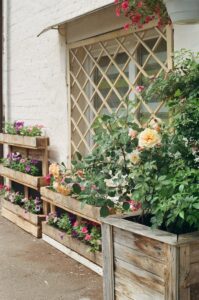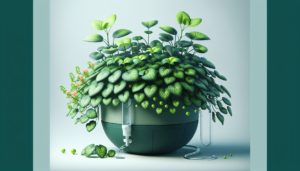Are you an avid gardener with limited space? Look no further! In our article “Maximizing Space in Your Vegetable Garden,” we will explore creative and practical ways to make the most of your garden area. Whether you have a small balcony or a tiny backyard or want to maximize efficiency, we have tips and tricks to help you grow a bountiful vegetable garden in any space. Get ready to transform your green thumb dreams into a reality!
Choosing the Right Vegetables
When it comes to vegetable gardening, choosing suitable vegetables is crucial for a successful harvest. One of the first things to consider is your climate and growing season. Different vegetables thrive in various climates, so selecting varieties well-suited to your region is essential. For example, if you live in an area with a short growing season, look for vegetables with a shorter maturity time. On the other hand, if you have a more extended growing season, you have more flexibility in the types of vegetables you can grow.
Another factor to consider when choosing vegetables is the amount of space you have available. Compact and space-saving varieties are a great option if you have a small garden or limited space. These varieties are specifically bred to take up less space while producing a bountiful harvest. Some examples include bush varieties of tomatoes and cucumbers and dwarf or patio varieties of peppers and eggplants. By choosing compact varieties, you can maximize your garden space and grow a wider variety of vegetables.
Additionally, focusing on high-yield crops is an intelligent strategy for maximizing space in your vegetable garden. High-yield crops produce a large quantity of vegetables per plant. For example, zucchini, green beans, and cherry tomatoes are known for their high-yield capabilities. You can make the most of your garden space and enjoy a plentiful harvest by choosing vegetables that are known for their productivity.
Planning your garden layout
Once you’ve chosen the suitable vegetables for your garden, the next step is to plan your garden layout. This involves mapping out your garden space and deciding where each vegetable will be planted. A well-planned garden layout maximizes space and ensures that each vegetable receives the appropriate amount of sunlight, water, and nutrients.
Start by measuring your garden space and sketching out a rough map. Consider existing structures, such as fences or trees that may affect sunlight and shade patterns. Consider how much space each vegetable will need to grow, and give them enough room to thrive. It’s also helpful to group plants with similar sunlight and water requirements. This will make it easier to care for your vegetables and avoid any potential conflicts.
Utilizing vertical gardening techniques is another effective way to maximize space in your vegetable garden. Vertical gardening involves growing plants upwards instead of outwards, using vertical space. There are several ways to incorporate vertical gardening into your garden layout. You can grow vining crops such as cucumbers, peas, and beans on trellises or arbors. Install vertical planters or hanging baskets to grow herbs or more miniature vegetables like lettuce and spinach. Training plants to grow upwards using stakes or cages is also a great option. You can grow more vegetables in a smaller footprint by utilizing vertical space.
For those with limited ground space, raised beds or containers are excellent alternatives. Raised beds are elevated garden boxes that provide better soil drainage and aeration. They also help to separate different types of soil and prevent soil erosion. Building raised beds allows you to maximize your gardening space and create a more manageable and organized garden layout. Containers, however, will enable you to grow vegetables in areas with limited soil, such as patios or balconies. Select the proper containers and spot soil for optimal plant growth when using containers. Consider growing dwarf or compact varieties in containers since they take up less space and are well-suited for container gardening. Finally, don’t forget to utilize vertical space by stacking containers to maximize your available space.
Companion planting
Companion planting is a gardening technique that involves growing different plants near one another to benefit from their symbiotic relationship. By companion planting, you can maximize your vegetable garden’s space while promoting healthy plant growth.
One critical principle of companion planting is to mix plants with similar growth habits and nutrient needs. This makes it easier to care for your plants and ensures that they won’t compete with one another for resources. For example, pairing tall plants like corn or sunflowers with shorter plants like beans or squash can create natural shade for the shorter plants while maximizing vertical space.
Companion planting can also help repel pests naturally. Certain plants emit scents or chemicals that act as natural pest deterrents. Planting pest-repelling plants alongside your vegetables can help protect them from common garden pests. For example, planting marigolds, nasturtiums, or basil alongside your tomatoes can deter pests like aphids and whiteflies. Incorporating companion planting principles into your garden layout can increase your vegetable yield and reduce the need for chemical pesticides.
Succession planting
Succession planting is a technique that involves staggering plantings to ensure a continuous harvest throughout the growing season. By removing finished crops and replacing them with new ones, you can make the most of your garden space and extend the harvest period for specific vegetables.
To implement succession planting, start by planning out your planting schedule. Determine the average harvest time for each vegetable and calculate when you should make additional plantings to ensure a continuous supply. For example, if you have a small garden and only enough space to plant a few lettuce plants at a time, you can sow a few seeds every two weeks. As the first batch of lettuce is harvested, the next batch will be ready for harvesting, ensuring a steady supply of fresh lettuce.
In addition to staggered plantings, crop rotation is essential in succession planting. Crop rotation involves changing the location of crops within your garden each year to prevent disease buildup and maintain soil fertility. By rotating crops, you can avoid pest and disease problems specific to certain vegetable families. It also helps to replenish soil nutrients, as different plants have different nutrient requirements. A well-planned succession planting schedule combined with proper crop rotation can help maximize space and ensure a productive vegetable garden.
Intensive planting
Intensive planting is a technique that involves planting vegetables closer together than traditional spacing recommendations. You can maximize your garden space and increase your vegetable yield by crowding plants.
When practicing intensive planting, it’s essential to consider each plant’s space requirements and growth habits. Some vegetables, such as lettuce or radishes, can be planted close together, while others, like tomatoes or peppers, need more space. Utilize intercropping and interplanting to make the most of your available space. Intercropping involves planting two or more different crops nearby, while interplanting refers to planting more minor crops between larger ones. For example, plant lettuce or spinach between rows of tomatoes or peppers. This way, the smaller plants benefit from the shade the larger plants provide, and you can maximize your garden space.
Square foot gardening is another popular technique for intensive planting. This involves dividing your garden into small square-foot sections and planting a specific number of plants in each section, depending on the vegetable’s space requirements. By using this approach, you can grow a variety of vegetables in a small space, making the best use of your garden area.
Vertical gardening
We briefly touched on vertical gardening earlier, but it’s worth highlighting this technique in more detail. Vertical gardening is a fantastic way to maximize space in your vegetable garden and add visual interest to your outdoor space.
A straightforward way to incorporate vertical gardening is to grow vining crops on trellises or arbors. Cucumbers, pole beans, and peas naturally climb and can be trained to grow upwards. By providing them with a support structure, you can encourage vertical growth and conserve ground space.
Another option for vertical gardening is to install vertical planters or hanging baskets. These allow you to grow plants vertically by utilizing walls, fences, or hanging structures. This is particularly useful if you have limited ground space but plenty of vertical space to work with.
Lastly, you can train plants to grow upwards using stakes or cages. This is commonly done with tomato plants, which tend to sprawl if left unsupported. By training your tomato plants to grow vertically, you can maximize space and keep the plants more organized and manageable.
Utilizing container gardening
For those with limited garden space or no access to a traditional garden bed, container gardening is the perfect solution. Container gardening allows you to grow vegetables in pots or containers, making them suitable for balconies, patios, or windowsills.
When using containers for vegetable gardening, it is essential to select the proper containers and potting soil. Choose containers with drainage holes to ensure adequate water drainage and prevent root rot. Well-draining potting soil formulated for container gardening is also essential for optimum plant growth.
To maximize space in container gardening, select dwarf or compact varieties of vegetables. These varieties are bred to take up less space while producing a generous harvest. For example, cherry tomatoes or mini bell peppers are excellent choices for container gardening. You can also consider growing herbs or salad greens with shallow root systems that can thrive in smaller pots.
Utilizing vertical space is the key to maximizing container gardening. One way to do this is by stacking containers vertically. This can be achieved using tiered plant stands or creating your vertical garden structure. By stacking containers, you can grow more plants in a smaller footprint and make the most of your available space.
Utilizing raised beds
Raised beds are a great option for vegetable gardening, especially if you have poor soil quality or limited garden space. They are essentially garden boxes elevated above the ground and filled with nutrient-rich soil.
One of the primary benefits of raised bed gardening is improved soil drainage and aeration. The elevated nature of raised beds allows excess water to drain more efficiently, preventing waterlogged soil and root rot. Additionally, the loose, well-draining soil in raised beds provides better aeration for plant roots, leading to healthier plants and increased yields.
Maximizing space in raised beds can be achieved by utilizing multiple tiers. Instead of having a single-level raised bed, consider building raised beds with various tiers. This allows you to grow crops at different heights and maximize your vertical space. For example, you can plant taller crops like tomatoes or pole beans at the back of the raised bed and shorter crops like lettuce or radishes in the front. By stacking crops vertically, you can increase your planting area and create a visually appealing garden.
Adding trellises or cages to your raised beds is another way to maximize space. This provides support for climbing plants like cucumbers, squash, or peas. You can take advantage of the vertical space above your raised beds by training these plants to grow vertically. Trellises or cages can be easily installed, allowing you to grow more vegetables in a smaller area.
Interplanting and intercropping
Interplanting and intercropping involve combining plants with different growth habits to maximize space and promote healthy plant growth.
Interplanting refers to planting more minor crops than larger ones. For example, grow lettuce or spinach between rows of tomatoes or peppers. This allows you to use the space between larger plants effectively, utilizing sunlight and soil nutrients. The smaller plants benefit from the shade the larger plants provide, and you can maximize your garden space.
Intercropping, on the other hand, involves planting two or more different crops nearby. This can help create a mutually beneficial relationship between the plants. For example, planting marigolds among your vegetables can help repel pests, thanks to their strong scent. Another example is growing herbs like basil or parsley near your tomato plants, which can improve the flavor of the tomatoes while deterring pests.
Combining plants with different growth habits and harvesting times can create a diverse and productive vegetable garden. Alternate rows or plants with varying maturity dates ensure a continuous fresh vegetable supply. Additionally, you can benefit from the complementary relationship of companion plants and use their natural properties to your advantage.
Crop rotation
Crop rotation is essential for maintaining your vegetable garden’s health and productivity. It involves avoiding planting the same family of vegetables in the same spot each year and following a proper crop rotation plan to prevent disease buildup and nutrient depletion.
Different families of vegetables have specific nutrient requirements and susceptibility to certain pests and diseases. By rotating crops, you can break the lifecycle of pests and diseases specific to a particular family of vegetables. For example, if you grew tomatoes in a specific bed last year, avoid planting them in the same spot this year. Instead, choose crops from a different family, such as lettuce or beans.
Crop rotation also helps replenish soil nutrients. Different plants have different nutrient requirements, and by rotating crops, you can ensure that the soil doesn’t become depleted of specific nutrients. For example, legumes like peas and beans can fix nitrogen in the soil, which is essential for healthy plant growth. Including legume crops in your rotation plan can naturally enrich the soil with nitrogen and reduce the need for synthetic fertilizers.
In conclusion, numerous strategies and techniques are available to maximize space in your vegetable garden. Each step plays a crucial role in a productive and efficient garden, from choosing suitable tables to utilizing vertical gardening techniques and implementing crop rotation. By carefully planning your garden layout and incorporating these strategies, you can make the most of your available space and enjoy a bountiful harvest year after year. Happy gardening!



